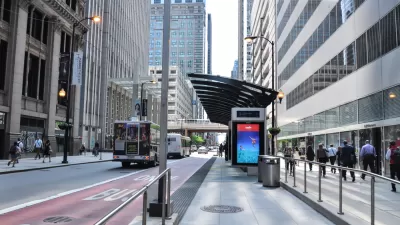The plan being proposed for a new bus-rapid-transit (BRT) line operating along busy Ashland Avenue would limit left turns and see the removal of a traffic lane. Will it survive "political vetting by Mayor Rahm Emanuel’s office"?
Chip Mitchell reports on the controversy surrounding the ambitious plan for 4.5 miles of Ashland Avenue being backed by the Chicago Transit Authority, the Chicago Department of Transportation and the Chicago Department of Housing and Economic Development. "The design favored by the Chicago planners resembles the boldest of four BRT alternatives the city presented last fall for the corridor. Each direction of Ashland would have one regular traffic lane and a bus-only lane near the middle of the avenue. In each direction, the design leaves a parking lane next to the sidewalk, city officials say. There would be no bike lanes." The route would incorporate other features including: station platforms, advanced payment, and prioritized traffic lights.
"Some Chicago business owners along the route are already voicing worries about BRT, particularly about eliminating non-bus lanes. 'The idea of cutting the traffic capacity in half has caused a lot of questions for businesses and property owners,' said Roger Romanelli, executive director of the Randolph/Fulton Market Association."
"City officials respond that their BRT plan would slow automobiles just slightly and speed up buses dramatically," notes Mitchell. "The city says the new bus service would be up to 80 percent faster than today’s service."
"Asked whether Emanuel was behind the plan and whether he would stick behind it if business owners revolted, his office had little to say. 'All of this is still under review,' Tom Alexander, a mayoral spokesman, wrote in an email message to WBEZ."
FULL STORY: Chicago planners push boldest bus-rapid-transit option

Planetizen Federal Action Tracker
A weekly monitor of how Trump’s orders and actions are impacting planners and planning in America.

Map: Where Senate Republicans Want to Sell Your Public Lands
For public land advocates, the Senate Republicans’ proposal to sell millions of acres of public land in the West is “the biggest fight of their careers.”

Restaurant Patios Were a Pandemic Win — Why Were They so Hard to Keep?
Social distancing requirements and changes in travel patterns prompted cities to pilot new uses for street and sidewalk space. Then it got complicated.

Platform Pilsner: Vancouver Transit Agency Releases... a Beer?
TransLink will receive a portion of every sale of the four-pack.

Toronto Weighs Cheaper Transit, Parking Hikes for Major Events
Special event rates would take effect during large festivals, sports games and concerts to ‘discourage driving, manage congestion and free up space for transit.”

Berlin to Consider Car-Free Zone Larger Than Manhattan
The area bound by the 22-mile Ringbahn would still allow 12 uses of a private automobile per year per person, and several other exemptions.
Urban Design for Planners 1: Software Tools
This six-course series explores essential urban design concepts using open source software and equips planners with the tools they need to participate fully in the urban design process.
Planning for Universal Design
Learn the tools for implementing Universal Design in planning regulations.
Heyer Gruel & Associates PA
JM Goldson LLC
Custer County Colorado
City of Camden Redevelopment Agency
City of Astoria
Transportation Research & Education Center (TREC) at Portland State University
Camden Redevelopment Agency
City of Claremont
Municipality of Princeton (NJ)



























